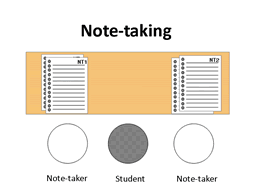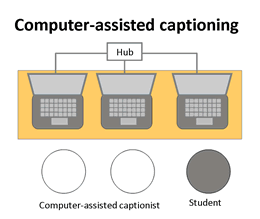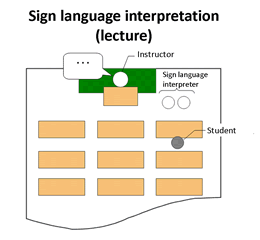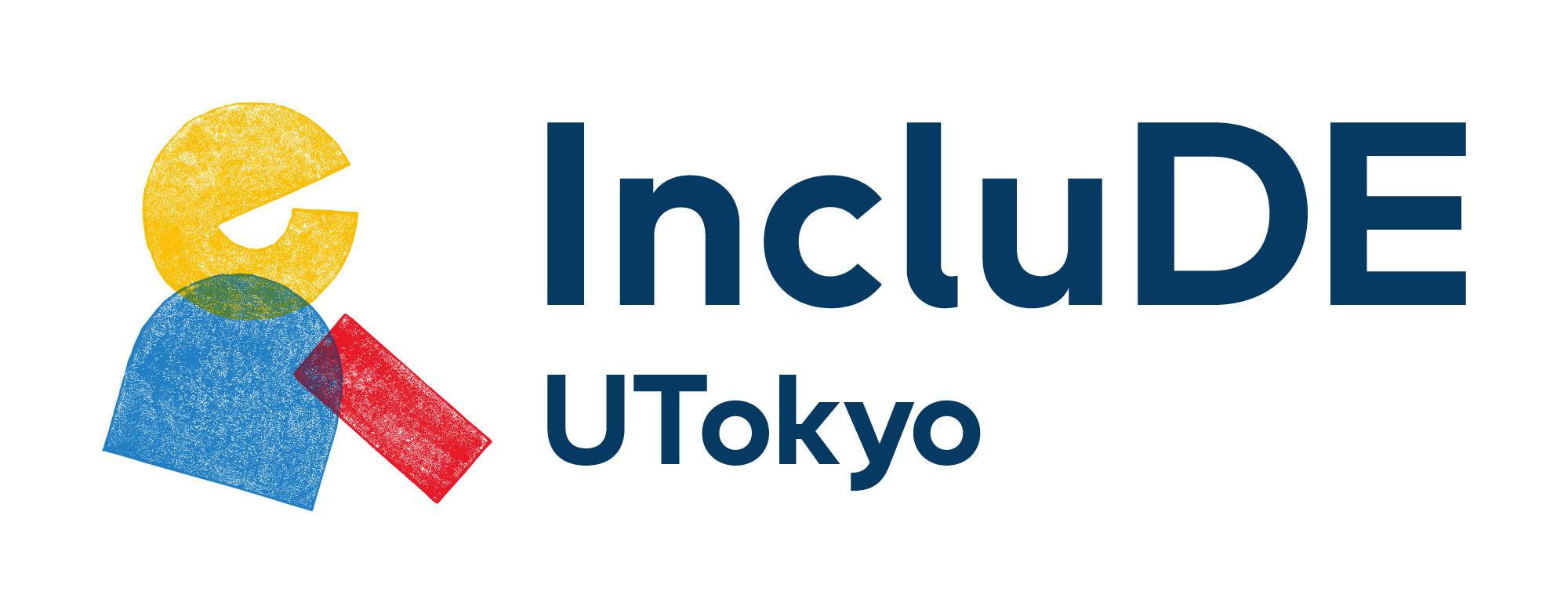Support Measures for Students with Hearing Impairment/Deafness
1.Accommodations in class
(1) Documents
●Distributing summaries
If you are able to prepare a document summarizing information such as the flow of the class, its content, and some keywords, this helps to supplement the hearing-impaired student’s information, and also facilitates the smooth interpretation of computer-assisted captioning. If you require help with printing out the summary document, please contact the support implementation officer in the relevant department/division.
(2) Writing on the blackboard/projecting slides
●Displaying important information on the blackboard/slides
Displaying important information such as keywords, technical terminology, proper nouns, and numbers on the blackboard or on a slide helps to accurately convey information to hearing-impaired students. This is especially important in the case for crucial information such as cancelled classes, exam dates and times, exam contents, and evaluation methods.
(3) Preparing text documents of video or voice materials
●Prepare documents/submit a request for captioning or transcribing
Voice and video materials contain a great amount of information, making it difficult for a computer note taker or interpreter to convey the material’s content sufficiently in real time. If you plan to use voice materials or video without captions in class, please prepare a document summarizing the material’s content. Materials can be transcribed or have captions added to them, so please ask the support implementation officer to take care of this, allowing ample time.
(4) Microphones
●Using a microphone
Depending on the student’s hearing ability and the size of the room, it can be easier for a hearing-impaired student to listen to the class if the teacher uses a microphone. Please check with the student, and use the microphone if there is one in the classroom. If the student uses a Hearing Assistance System (a system which sends the teacher’s voice via a transmitter to a receiver the hearing-impaired student has at a location far from the teacher), this requires the use of a dedicated microphone, so please use the microphone the student brings with him or her, rather than the classroom microphone.
(5) Consideration for interpreters
Text interpreters such as note takers andcomputer-assisted captionists, or sign language interpreters may be sent to help at classes attended by hearing-impaired students. If these interpreters are present, please keep the following points in mind.
●Provide documents in advance
Wherever possible, please give the interpreter any documents or summaries that will be used in lectures in advance. Being able to read these materials before the lecture helps the interpreter to perform more smoothly. For details on how to hand the documents over, or how they should be handled, please contact the support implementation officer. (If the method for handing documents over is decided on before the start of the semester, this enables a smooth process.)
●Provide interpreter with slide materials
Wherever possible, please print out the slides to be used in class and give them to the interpreter. Especially for explanations of tables or graphs, it is easier to interpret if the interpreter has a document at hand that can be written on directly.
●Specify the section of the document you are reading
Sometimes it takes a moment for the interpreter to realize the teacher is reading out a document or some text, as the interpreter is concentrating hard on interpreting. If you specify the section before you start reading, such as by saying, “I will now read out page XX”, this helps the interpreter to follow.
●Avoid using too many directives
Sometimes interpreters need to change directives (words such as ‘this’ or ‘that’) for specific terms when explaining the writing on the blackboard, documents, or graphs. If you can use specific terms to explain things rather than directives wherever possible, this helps to ensure the information is conveyed accurately.
●Seat reservations for interpreters
Interpreters generally sit in a position relative to the hearing-impaired student as shown below. If the class is attended by a large number of students, please cooperate to ensure there is an appropriate seat for the interpreter. The images below are only representative examples, and may need to be changed to suit the classroom’s condition (the positioning of windows or slide projector, etc.) or the hearing-impaired student’s preference.
 |
 |
 |
 |
(6) About tutorials and group work
●Avoid letting people talk at the same time, and indicate who may speak using visual cues
If several students are speaking simultaneously, this makes it extremely difficult for a hearing-impaired student to grasp the content of the discussion. Interpreters cannot handle more than one speaker at a time either. Please nominate a discussion facilitator and monitor the discussion so that students do not speak at the same time, have students raise their hands to speak and use visual cues to indicate who may speak. Please also check that the hearing-impaired student is following the discussion as it continues. There may be other considerations needed depending on the classroom’s size and condition, the student’s hearing ability, and the presence of an interpreter. Please discuss this with the hearing-impaired student and consider what measures are necessary.
(7) Other
●Adjustments to methods for checking attendance and calling on students
Hearing-impaired students may not realize when their name has been called for attendance, or if they have been called on to answer a question. When calling the student’s name, it helps to make eye contact with the student and say their name at the start of the sentence. It is also useful if you decide on a way to confirm attendance with the hearing-impaired student in advance.
●Adjustments to other students’ comments in class
When other students make comments or ask questions, understanding is promoted if the teacher has them use a microphone so their voices can be heard clearly, and if the teacher acts as facilitator and summarizes the information presented.
2.Accommodations for exams
Please consider the following kinds of accommodations for exams, in accordance with the hearing-impaired student’s situation. The student and support implementation officer will make specific requests to you before the exam, after having spoken with the ODE.
●Consider a method for conveying orally-presented information during the exam
Please ensure that orally-presented information such as points of caution for the exam or amendments to exam questions are conveyed in a visual method such as on the blackboard or on paper hand-outs.
●Alternative exam methods or inclusion of interpreters for listening tests or oral exams
Hearing ability and accuracy of pronunciation varies from individual to individual. Below are some examples for how to deal with listening tests or oral exams. For further information, please contact the support implementation officer or the ODE.
e.g. Swap a listening test or oral exam for a report or written exam / Change the oral exam format to a one-on-one format, or allow the attendance of an interpreter / Allow the test to be taken individually in a separate room so that surrounding noises do not interfere / Allow the use of hearing aids or Hearing Assistance Systems
*Please note that even with the use of hearing aids or Hearing Assistance Systems, the student may not be able to hear to the same extent as a non-impaired student. For more information, please see ‘What you should know about hearing impairments’.





